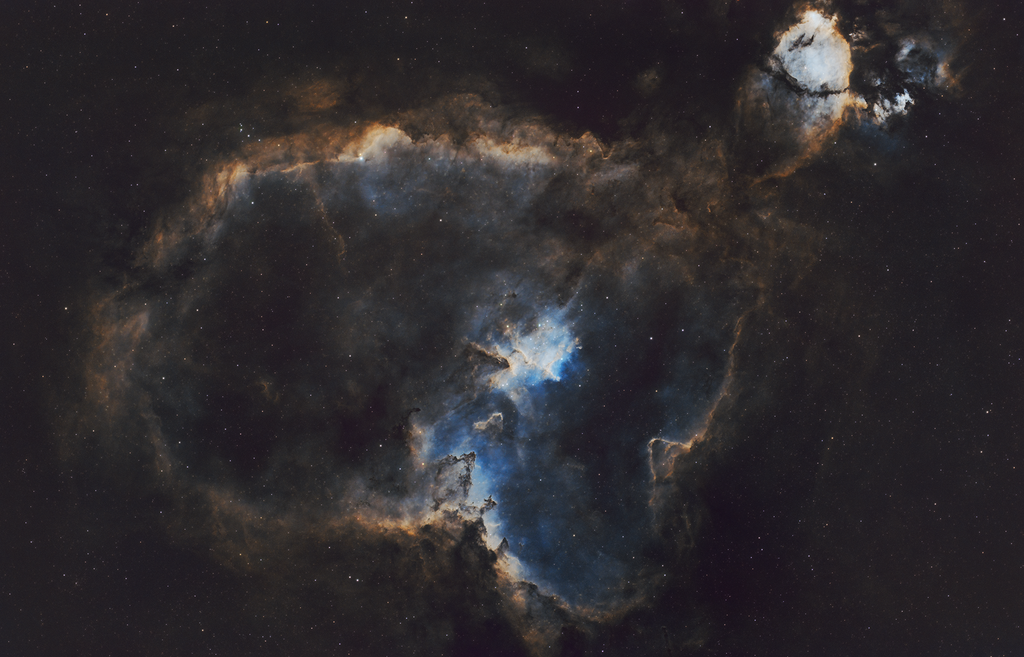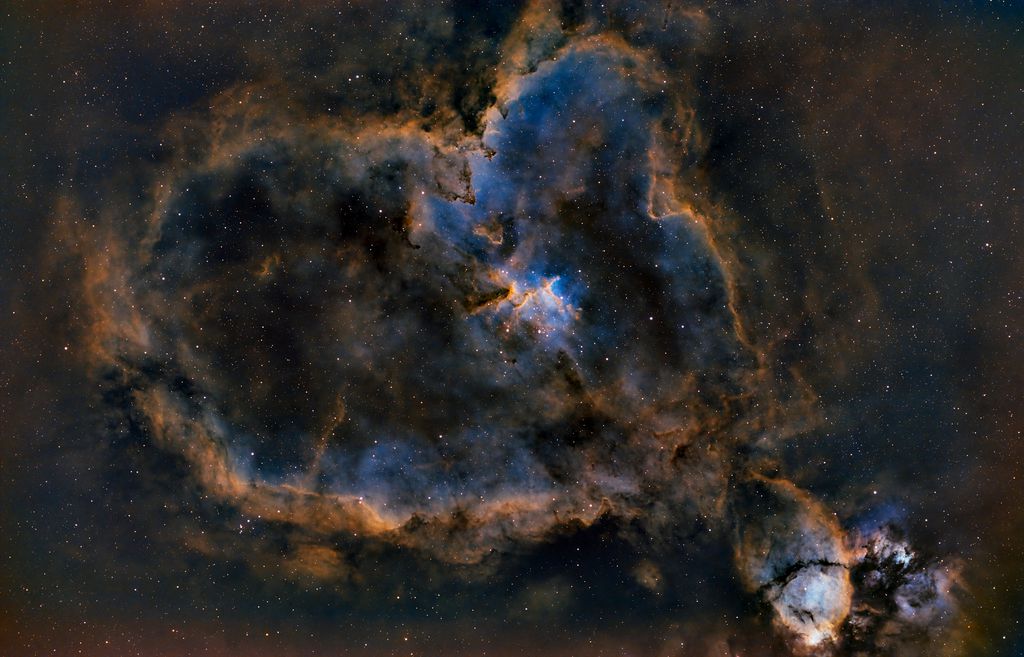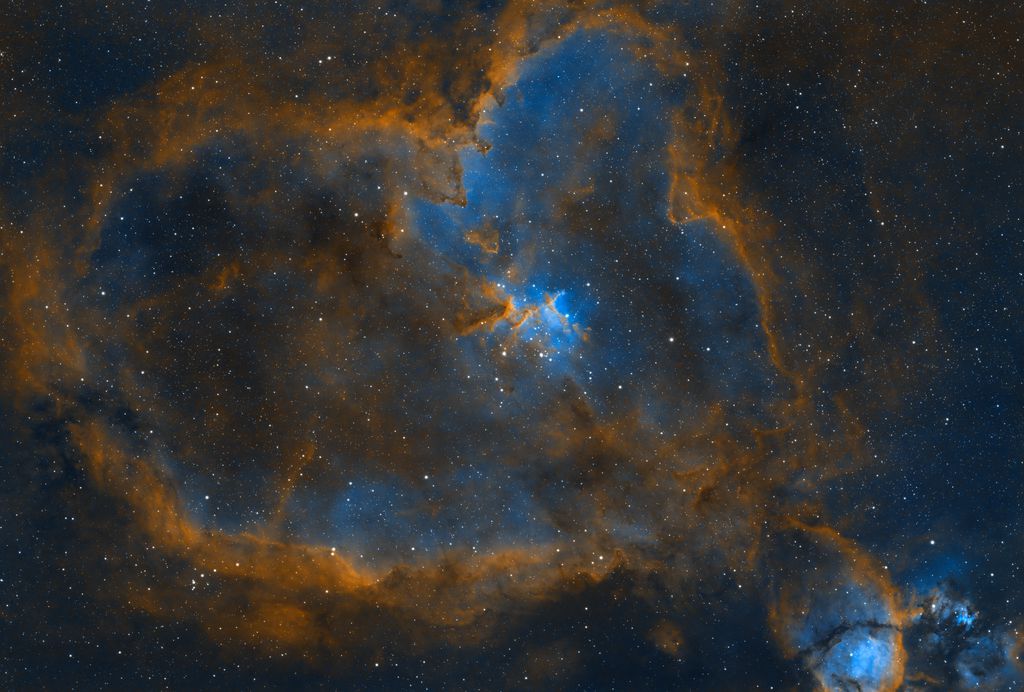IC 1805
Shared folder with HSO masters. XSIF so for the PI people.
Can't figure this out. I can't seem to get ANY blue out of this. I'm sure it's me...  |
You cannot like this item. Reason: "ANONYMOUS".
You cannot remove your like from this item.
Editing a post is only allowed within 24 hours after creating it.
You cannot Like this post because the topic is closed.
Just PI people? How about the Siril people?
EDIT: I'm processing it with Siril, hehehe!!!
I use Graxpert to convert XISF to TIFF
|
You cannot like this item. Reason: "ANONYMOUS".
You cannot remove your like from this item.
Editing a post is only allowed within 24 hours after creating it.
You cannot Like this post because the topic is closed.
I'm still relatively new to mono processing so I tried processing it for fun and man do I wish my data was this good. There is definitely blue in there. I used Siril and Photoshop instead of PI but the process is essentially the same.
I assigned SHO data to RGB channels in Photoshop and then in Siril I ran color calibration > remove green noise (I think it's called SCNR in PI) > background extraction > star removal > small stretch > increase saturation > another small stretch > increased saturation a tad more > star recomposition w/ a small stretch again to brighten it up and then topaz denoise.
Took me about 20 minutes and it was good practice so thanks. Most important parts I think in getting the blue to show is color calibration > remove green noise > increase saturation.  |
You cannot like this item. Reason: "ANONYMOUS".
You cannot remove your like from this item.
Editing a post is only allowed within 24 hours after creating it.
You cannot Like this post because the topic is closed.
You gave no info and I don't think the data is top notch. A lot of gradient. I get more blue with a NB filter on an OSC camera.
Maybe better calibration? Other more talented people may better.
PP in Pix, Affinity, Photoshop, Capture one,
Quick edit.
|
You cannot like this item. Reason: "ANONYMOUS".
You cannot remove your like from this item.
Editing a post is only allowed within 24 hours after creating it.
You cannot Like this post because the topic is closed.
Well, I tried...
Had no good noise reduction tools, so had to keep it a little dim.
But hey, I definitely got the blues!

This is what I did:
-SHO combination
-Color Calibration
-Background Extraction
-Starnet
-Decreased green with curves on Starless
-Increased blue with curves on Starless
-Messed with saturation on all colors (I don't remember exactly what I did) on Starless
-Did Asinh black point increase
-Did Stars and Starless recombination
-Brought into Photoshop, increased highlights a little
-Used Camera Raw, decreased color noise by 100%
|
You cannot like this item. Reason: "ANONYMOUS".
You cannot remove your like from this item.
Editing a post is only allowed within 24 hours after creating it.
You cannot Like this post because the topic is closed.
Damn. I have no idea what I’m doing haha.
guess I’m watching videos for the next week.
|
You cannot like this item. Reason: "ANONYMOUS".
You cannot remove your like from this item.
Editing a post is only allowed within 24 hours after creating it.
You cannot Like this post because the topic is closed.
|
No offence but you have a very bad flat technique. I would start addressing that. And I wouldn't shoot in bin1 either with that camera with faint subjects.
|
You cannot like this item. Reason: "ANONYMOUS".
You cannot remove your like from this item.
Editing a post is only allowed within 24 hours after creating it.
You cannot Like this post because the topic is closed.
Hi. This is my attempt, I hope you like it.
It is the first time I work with mono data anyway.
Things to consider: SII and OIII data had gradients, so I removed them first thing individually. Also, they lacked signal, that's why it doesn't show very much.
Steps:
*Gradient correction (automatic convergence) on SII and OIII.
*RGB combination in SHO.
*BXT correct only
*Another gradient correction pass on the composite image.
*NXT 0.39/0.39
*Linked stretch ( I haven't tried with an unlinked stretch, sometimes it helps boost oxygen when it is not high in signal)
*Star removal.
*Bill Blanshan's SHO Normalization V5 with SII Boost at 1.2 and OIII Boost at 1.2 (these signals were both rather low)
*Green cast reduction.
*Play with the green curves to achieve the beautiful colour gradations of this palette.
*Noise reduction with Topaz.
*Stars back (saturated).

|
You cannot like this item. Reason: "ANONYMOUS".
You cannot remove your like from this item.
Editing a post is only allowed within 24 hours after creating it.
You cannot Like this post because the topic is closed.
This is a SHO (Foraxx) rendering (very very weak OIII signal):
 |
You cannot like this item. Reason: "ANONYMOUS".
You cannot remove your like from this item.
Editing a post is only allowed within 24 hours after creating it.
You cannot Like this post because the topic is closed.
Sean Mc:
IC 1805
Shared folder with HSO masters. XSIF so for the PI people.
Can't figure this out. I can't seem to get ANY blue out of this. I'm sure it's me... 
Curves. This is the secret weapon. ;) In PI, in particular, you have access to the a* and b* curves. This is one of the key tools you can use to shift colors around, and bring out things like blue. I'm downloading the data now, although I have a lot of other things to do today. In the mean time, try the a* and b* curves in PI'x CurvesTransformation tool. Oh, and use it on stretched data...on linear, these two curves are hypersensitive and basically impossible to use.
|
You cannot like this item. Reason: "ANONYMOUS".
You cannot remove your like from this item.
Editing a post is only allowed within 24 hours after creating it.
You cannot Like this post because the topic is closed.
andrea tasselli:
No offence but you have a very bad flat technique. I would start addressing that. And I wouldn't shoot in bin1 either with that camera with faint subjects.
No offence taken. I’m struggling greatly with flats/darks. Asi294mm pro. I have a dimmable flat panel and some ND sheets that I put over it.
This is also at least bortle 8 data. It’s not new and I probably took it in sub-par sky conditions.
i thought bin1 and bin2 were simply scaling? Doesn’t downsampling bin1 effectively give you the same pic as bin2?
|
You cannot like this item. Reason: "ANONYMOUS".
You cannot remove your like from this item.
Editing a post is only allowed within 24 hours after creating it.
You cannot Like this post because the topic is closed.
Sean Mc:
No offence taken. I’m struggling greatly with flats/darks. Asi294mm pro. I have a dimmable flat panel and some ND sheets that I put over it.
This is also at least bortle 8 data. It’s not new and I probably took it in sub-par sky conditions.
i thought bin1 and bin2 were simply scaling? Doesn’t downsampling bin1 effectively give you the same pic as bin2?
By the look of it it could have been that the flats undercorrect or simply they are wrong. While I'd have expected the OIII to be bad the SII had even worse profile than the OIII, more difficult to flatten, which was a surprise.
The 294 sensor bin2 is a rather different affair than just bin1 averaged by four, it's a much better mode in respect to effective dynamics and RON. I wonder what gain settings you have used. The main issue here that scaling up doesn't really work for either SHO or RGB imaing, both should be at their lowest common scale.
|
You cannot like this item. Reason: "ANONYMOUS".
You cannot remove your like from this item.
Editing a post is only allowed within 24 hours after creating it.
You cannot Like this post because the topic is closed.
Gain 121 for both bin1 and bin2. the s-ii and o-iii are both bin2. Ha is bin1.
In this case, it's the bin1 data that worked the best.
|
You cannot like this item. Reason: "ANONYMOUS".
You cannot remove your like from this item.
Editing a post is only allowed within 24 hours after creating it.
You cannot Like this post because the topic is closed.
|
I put the flats for s-ii and o-iii in the shared folder.
|
You cannot like this item. Reason: "ANONYMOUS".
You cannot remove your like from this item.
Editing a post is only allowed within 24 hours after creating it.
You cannot Like this post because the topic is closed.
I think you really could use more integration time for the Oiii and Sii channels. Here is a quick and dirty processing I did of your data. I cropped the image due to the edges having what looks like bad correction. |
You cannot like this item. Reason: "ANONYMOUS".
You cannot remove your like from this item.
Editing a post is only allowed within 24 hours after creating it.
You cannot Like this post because the topic is closed.
I used the processing used by the channel Entering Into Space: https://youtu.be/cn7UGWlPxfI
I just used the Ha stars in the final image.
|
You cannot like this item. Reason: "ANONYMOUS".
You cannot remove your like from this item.
Editing a post is only allowed within 24 hours after creating it.
You cannot Like this post because the topic is closed.
|
The ratio for IC1805 are 1:2:4 for the Ha-SII-OIII components.
|
You cannot like this item. Reason: "ANONYMOUS".
You cannot remove your like from this item.
Editing a post is only allowed within 24 hours after creating it.
You cannot Like this post because the topic is closed.
|
Not sure what you mean by ratio 1:2:4 ?
|
You cannot like this item. Reason: "ANONYMOUS".
You cannot remove your like from this item.
Editing a post is only allowed within 24 hours after creating it.
You cannot Like this post because the topic is closed.
Sean Mc:
I put the flats for s-ii and o-iii in the shared folder.
Interesting. Can you put also a raw/unprocessed OIII/SII file in there as well? It looks like you are overcorrecting.
|
You cannot like this item. Reason: "ANONYMOUS".
You cannot remove your like from this item.
Editing a post is only allowed within 24 hours after creating it.
You cannot Like this post because the topic is closed.
Sean Mc:
Not sure what you mean by ratio 1:2:4 ?
Ratio of total integrated times.
|
You cannot like this item. Reason: "ANONYMOUS".
You cannot remove your like from this item.
Editing a post is only allowed within 24 hours after creating it.
You cannot Like this post because the topic is closed.
I’ll see if I still have them when i get home and I’ll put them in the folder.
so are you saying that the “signal strength” or whatever it’s called is 1x ha, and 4x oxygen? All three filters were 300s subs and I think I had more ha than o or s.
or… are you saying i SHOULD have 1:2:4?
|
You cannot like this item. Reason: "ANONYMOUS".
You cannot remove your like from this item.
Editing a post is only allowed within 24 hours after creating it.
You cannot Like this post because the topic is closed.
Sean Mc:
I’ll see if I still have them when i get home and I’ll put them in the folder.
so are you saying that the “signal strength” or whatever it’s called is 1x ha, and 4x oxygen? All three filters were 300s subs and I think I had more ha than o or s.
For one hour of integration time of Ha, you would ideally have 2 hours of integration time for sulfur and then 4 hours for oxygen.
|
You cannot like this item. Reason: "ANONYMOUS".
You cannot remove your like from this item.
Editing a post is only allowed within 24 hours after creating it.
You cannot Like this post because the topic is closed.
andrea tasselli:
The ratio for IC1805 are 1:2:4 for the Ha-SII-OIII components.
How'd you figure out about this ratio thing? Is it made up or is there someplace online that gives info about the best ratios for different emission nebulae?
EDIT: Is it 1:2:4 for all emission nebulae?
|
You cannot like this item. Reason: "ANONYMOUS".
You cannot remove your like from this item.
Editing a post is only allowed within 24 hours after creating it.
You cannot Like this post because the topic is closed.
|
If you expose Ha for an hour think 2 for SII and 4 for OIII to have comparable signal strengths (shooting in B6/B7).
|
You cannot like this item. Reason: "ANONYMOUS".
You cannot remove your like from this item.
Editing a post is only allowed within 24 hours after creating it.
You cannot Like this post because the topic is closed.
andrea tasselli:
The ratio for IC1805 are 1:2:4 for the Ha-SII-OIII components.
How'd you figure out about this ratio thing? Is it made up or is there someplace online that gives info about the best ratios for different emission nebulae?
EDIT: Is it 1:2:4 for all emission nebulae?
*I just figured out a relative ratio based on personal experience. I normally try to get twice as much Oiii compared to Ha. Since I shoot at f/3.3 then I have mostly been getting 1:1:1 and that has worked out well. For my slower scopes I definitely try to get more Sii and Oiii compared to Ha. The Ha signal is normally fairly strong compared to Sii and Oiii. You need more integration time for Sii and Oiii to get more of the faint signal.
|
You cannot like this item. Reason: "ANONYMOUS".
You cannot remove your like from this item.
Editing a post is only allowed within 24 hours after creating it.
You cannot Like this post because the topic is closed.
to create to post a reply.









